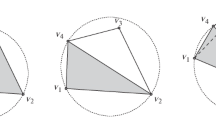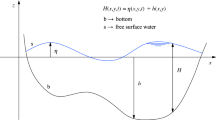Abstract
A new concept called a boat-sail distance is introduced on the surface of water with flow, and it is used to define a generalized Voronoi diagram, in such a way that the water surface is partitioned into regions belonging to the nearest harbors with respect to this distance. The problem of computing this Voronoi diagram is reduced to a boundary value problem of a partial differential equation, and a numerical method for solving this problem is constructed. The method is a modification of a so-called fast marching method originally proposed for the eikonal equation. Computational experiments show the efficiency and the stableness of the proposed method.
Similar content being viewed by others
References
O. Aichholzer, F. Aurenhammer, D.Z. Chen and D.T. Lee, Skew Voronoi diagrams. International Journal of Computational Geometry and Applications,9 (1999), 235–247.
B. Aronov and J. O’Rourke, Nonoverlap of the star unfolding. Discrete and Computational Geometry,8 (1992), 219–250.
B. Aronov, On the geodesic Voronoi diagram of point sites in a simple polygon. Algorithmica,4 (1989), 109–140.
P.F. Ash and E.D. Bolker, Generalized Dirichlet tessellations. Geometriae Dedicata,20 (1986), 209–243.
F. Aurenhammer, Power diagrams — Properties, algorithms and applications. SIAM Journal of Computing,16 (1987), 78–96.
F. Aurenhammer, Voronoi diagrams — A survey of a fundamental geometric data structure. ACM Computing Surveys,23 (1991), 345–405.
F. Aurenhammer and H. Edelsbrunner, An optimal algorithm for constructing the weighted Voronoi diagram in the plane. Pattern Recognition,17 (1984), 251–257.
L.P. Chew and R. Drysdale, III, Voronoi diagrams based on convex distance functions. Proceedings of the ACM Symposium on Computational Geometry, Baltimore, 1985, 235–244.
S. Fortune, Voronoi diagrams and Delaunay triangulations. Computing in Euclidean Geometry (eds. D.-Z. Du and F.K. Hwang), World Scientific Publishing, Singapore, 1992, 193–233.
H. Imai, M. Iri and K. Murota, Voronoi diagram in the Laguerre geometry and its applications. SIAM Journal of Computing,14 (1985), 93–105.
R. Klein, Abstract Voronoi diagrams and their applications. Lecture Notes in Computer Science333 (International Workshop on Computational Geometry, Wurzburg, 1988), Springer-Verlag, Berlin, 1988, 148–157.
K. Kobayashi and K. Sugihara, Crystal Voronoi diagram and its applications. Future Generation Computer System,18 (2002), 681–692.
D.-T. Lee, Two-dimensional Voronoi diagrams in the Lp-metric. Journal of the ACM,27 (1980), 604–618.
R.E. Miles, Random points, sets and tessellations on the surface. The Indian Journal of Statistics, Series A,33 (1971), 145–174.
A. Okabe, B. Boots, K. Sugihara and S.N. Chiu, Spatial Tessellations — Concepts and Applications of Voronoi Diagrams (Second Edition). John Wiley and Sons, Chichester, 2000.
B.F. Schaudt and R.L. Drysdale, Multiplicatively weighted crystal growth Voronoi diagrams. Proceedings of the Seventh Annual ACM Symposium on Computational Geometry, 1991, 214–223.
T.H. Scheike, Anisotropic growth of Voronoi cells. Advances in Applied Probability,26 (1994), 43–53.
J.A. Sethian, Fast marching method. SIAM Review,41 (1999), 199–235.
J.A. Sethian, Level Set Methods and Fast Marching Methods (Second Edition). Cambridge University Press, Cambridge, 1999.
K. Sugihara, Voronoi diagrams in a river. International Journal of Computational Geometry and Applications,2 (1992), 29–48.
Author information
Authors and Affiliations
Corresponding author
About this article
Cite this article
Nishida, T., Sugihara, K. Boat-sail Voronoi diagram and its computation based on a cone-approximation scheme. Japan J. Indust. Appl. Math. 22, 367–383 (2005). https://doi.org/10.1007/BF03167490
Received:
Revised:
Issue Date:
DOI: https://doi.org/10.1007/BF03167490




